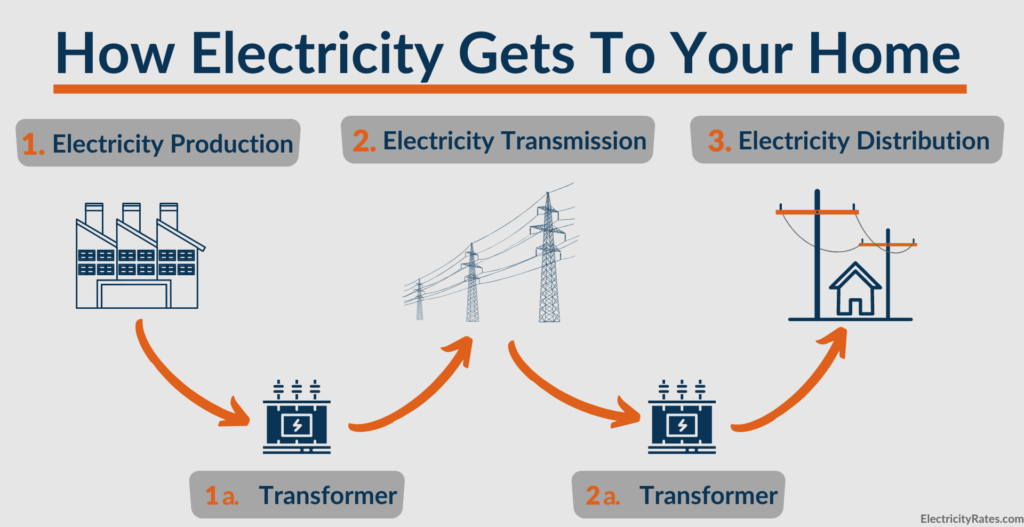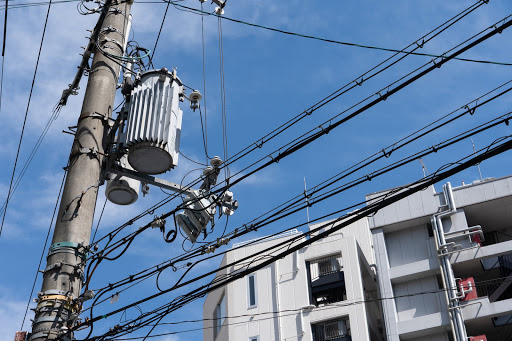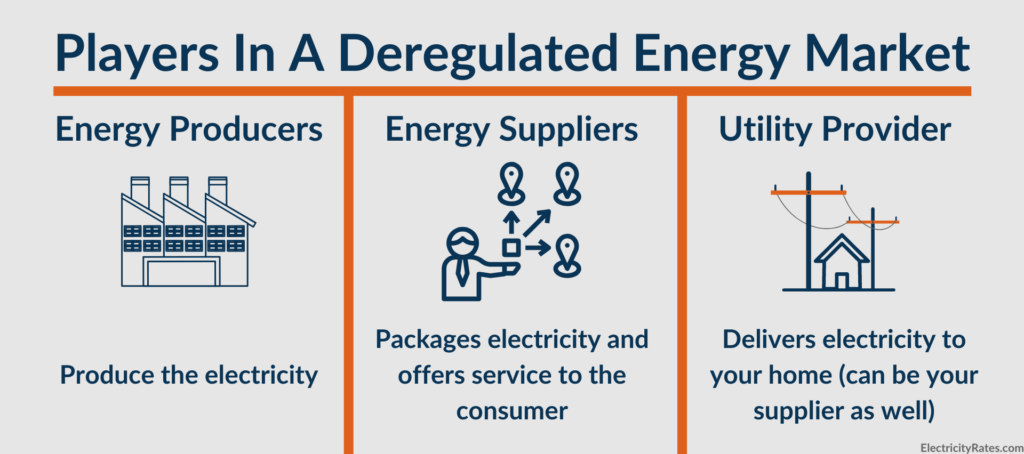The browser you are using is not supported. Please consider using a modern browser.

Guide To Your Home’s Electricity Supply & Power Connection
At the most basic level, electricity gets to your home in a simple three-step process. The entities involved in each step, and the rules governing them, often vary by state.
How Electricity Gets To Your Home

Electricity gets to your home is a simple three-step process. In between each step is a transformer that helps with the transition to the next one.
- Electricity is produced
- Produced electricity is sent to a transformer to transition to step 2
- Electricity is transmitted
- Transmitted electricity is sent to a transformer to transition to step 3
- Electricity is distributed
Step One: Electricity Production
Electricity is produced at a power plant. It could be a wind farm, a coal plant, a nuclear facility, or a whole variety of other power producers.
What makes up your electricity is likely a combination of multiple sources of energy and will vary heavily from state to state. For instance, nuclear energy makes up 20% of electricity generated in the US, but if you live in Pennsylvania that number is almost 40%. A mix of political policy and geographical access to resources often determines what a state uses for electricity production.
Although your energy may come from a variety of sources, the way electricity is produced is all the same (save for PV solar energy), which is by spinning a turbine through the use of steam, wind, or whatever other technique a particular fuel uses. The spinning turbine’s mechanical energy is then converted into electrical energy.
After electrical energy is produced, it is sent to a transformer to prepare it for the second step.
Step Two: Electricity Transmission
The main thing that the transformer does is increase the voltage for transmission lines. Transmission lines are those massive towers that you see along a highway.

These lines carry the electricity long distances to get it to the distribution system in step three. Voltage is increased in this step because it is cheaper to transfer large amounts of energy this way.
Step Three: Electricity Distribution
Along the way, transmission lines will dispense electricity to local neighborhood transformers.

These transformers decrease the voltage before distribution lines carry the electricity to local residences and businesses. Although it is more expensive to transfer energy at a lower voltage, it is safer for home and business use.
How Electricity Grids Are Connected
Electricity in the US is largely interconnected. This allows for a more reliable transmission of electricity for everyone. Originally, grids operated independently from one another. Today, they are split into three independent, but very large, grids.
- The Eastern Interconnection encompasses most of the east coast and the south, all the way to the Rocky Mountains.
- The Western Interconnection covers everything from the Rockies to the west.
- The Electric Reliability Council of Texas (ERCOT) covers almost all of Texas besides the northern panhandle, which is a part of the Eastern Interconnection.
The US Energy Information Administration has a map of these three electric grids and their balancing authorities (balancing authorities ensure the grids are balanced and delivering energy reliably).

Who Owns The Electricity Grid Connections?
All three of the above connections are owned and shared by a variety of companies, non-profit entities, and government entities. These partnerships are a win-win for everyone involved because it helps make energy cheaper and more reliable.
Who owns the specific parts of the electricity production/transmission/distribution is complicated, because it changes depending on your location.
Traditional Energy Market
Most of the United States runs on a traditional energy market. This means that they essentially run a monopoly that is regulated by a Public Utilities Commission (PUC).
The monopoly could be government-owned, or it could be private. It could be for-profit or non-profit. It could just be in charge of the distribution, or in a few cases, it could operate the production, transmission, and distribution of electricity.
However, in every case, the PUC is there to set fair rates so consumers are not taken advantage of. In these traditional energy markets, how your electricity is produced and the cost is decided for you.
Three Players In A Deregulated Energy Market
Recently, many states have deregulated their energy markets. This means that consumers were now allowed to pick their energy suppliers, meaning they don’t have to stick with their utility’s service.
It helps to visualize this by splitting this into three different parts.

- Energy producers: these generate the electricity that gets to your home. Think step 1 from above.
- Energy suppliers: these are companies that offer energy packages to customers in deregulated states. They package electricity from energy producers and set their rates. This electricity is then delivered through the customer’s local utility provider.
- Local utility provider: this is the entity that brings electricity to your home. In a traditional market, or if you have never switched suppliers in a deregulated market, the utility provider is also your energy supplier.
A deregulated market allows the customer to switch energy suppliers. This increases competition and helps keep prices low (often lower than their utility provider’s prices). It also gives the consumer more choices on where their electricity comes from, like if they want 100% renewable energy.
If the consumer decides to switch, there are no interruptions in their service. That is because the utility is still physically getting the electricity to your home. Only the energy supplier has changed.
If you are interested in switching energy suppliers, you can see your options right here on ElectricityRates.com. Just type in your ZIP Code. If you see a plan that you like, just select it and we will guide you from there.
Check out our homepage to see how we make switching electricity providers simple and easy.